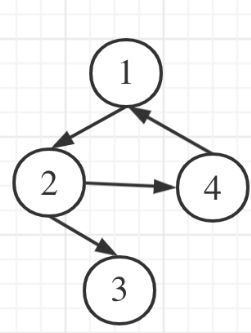算法|图论 6 并查集
并查集基本模板:
int n = 10;
vector UFSets(n,0);//若将初值全设置为-1,那就不用再有初始化操作了。
//初始化
void Initial(vector S[]){
for(int i=0;i &S,int x){
int root = x;
while(s[root] >= 0) root = S[root]//先找到x的根
while(x != root){//压缩路径
int t = S[x];//首先找到x的父亲,防止一会丢失找不到了
S[x] = root;//将x挂到根节点下
x = t;//再让x变为其父亲,将路径上所有节点都直接挂到根上
}
return root;
}
void Union(vector &S,int x,int y){
int Root1 = Find(S,x);
int Root2 = Find(S,y);
if(Root1 == Root2) return;
if(S[Root2] > S[Root1]){//Root2节点数少,应该将其挂在Root1上面
S[Root1] += S[Root2];//将两个集的节点数加起来
S[Root2] = Root1;//小树挂到大树上去
}else{
S[Root2] += S[Root1];
S[Root1] = Root2;
}
return ;
} LeetCode 1971- 寻找图中是否存在路径
题目链接:力扣(LeetCode)官网 - 全球极客挚爱的技术成长平台
题目描述:有一个具有 n 个顶点的 双向 图,其中每个顶点标记从 0 到 n - 1(包含 0 和 n - 1)。图中的边用一个二维整数数组 edges 表示,其中 edges[i] = [ui, vi] 表示顶点 ui 和顶点 vi 之间的双向边。 每个顶点对由 最多一条 边连接,并且没有顶点存在与自身相连的边。
请你确定是否存在从顶点 source 开始,到顶点 destination 结束的 有效路径 。
给你数组 edges 和整数 n、source 和 destination,如果从 source 到 destination 存在 有效路径 ,则返回 true,否则返回 false 。
解题思路
使用并查集,初始我们将所有边都每个edges都Union,这样就将连在一起的边都接在同一个树下了,然后再find找到看是否为同一个根,是则返回true,否则返回false。
class Solution {
public:
//初始化
void Initial(vector &S){
for(int i=0;i &S,int x){
int root = x;
while(S[root] >= 0) root = S[root];//先找到x的根
while(x != root){//压缩路径
int t = S[x];//首先找到x的父亲,防止一会丢失找不到了
S[x] = root;//将x挂到根节点下
x = t;//再让x变为其父亲,将路径上所有节点都直接挂到根上
}
return root;
}
void Union(vector &S,int x,int y){
int Root1 = Find(S,x);
int Root2 = Find(S,y);
if(Root1 == Root2) return;
if(S[Root2] > S[Root1]){//Root2节点数少,应该将其挂在Root1上面
S[Root1] += S[Root2];//将两个集的节点数加起来
S[Root2] = Root1;//小树挂到大树上去
}else{
S[Root2] += S[Root1];
S[Root1] = Root2;
}
return ;
}
bool validPath(int n, vector>& edges, int source, int destination) {
vector UFSets(n,-1);//若将初值全设置为-1,那就不用再有初始化操作了。
for(int i=0;i 总结:并查集的Union就可以用来初始化边与边之间的联系,不需要你手动去给每个根和节点赋值。
LeetCode 684- 冗余连接
题目链接:力扣(LeetCode)官网 - 全球极客挚爱的技术成长平台
题目描述:树可以看成是一个连通且 无环 的 无向 图。
给定往一棵 n 个节点 (节点值 1~n) 的树中添加一条边后的图。添加的边的两个顶点包含在 1 到 n 中间,且这条附加的边不属于树中已存在的边。图的信息记录于长度为 n 的二维数组 edges ,edges[i] = [ai, bi] 表示图中在 ai 和 bi 之间存在一条边。
请找出一条可以删去的边,删除后可使得剩余部分是一个有着 n 个节点的树。如果有多个答案,则返回数组 edges 中最后出现的那个。
解题思路
和上一题的区别就是我们这次需要删除一条冗余的边。这次我们不直接union节点,我们先判断,若这两条边没有连在一起,也就是根不同,我们再union。若这两条边已经连在一起,就说明现在这条边是冗余的了,我们就直接返回这条边即可。
class Solution {
public:
int Find(vector &S,int x){
int root = x;
while(S[root] >= 0) root = S[root];
while(x != root){
int t = S[x];
S[x] = root;
x = t;
}
return root;
}
void Union(vector &S,int x,int y){
int root1 = Find(S,x);
int root2 = Find(S,y);
if(root1 == root2) return;
if(S[root1] > S[root2]){//root2根下树叶多一些
S[root2] += S[root1];
S[root1] = root2;
}else{
S[root1] += S[root2];
S[root2] = root1;
}
}
vector findRedundantConnection(vector>& edges) {
vector UFSets(1001,-1);
for(int i=0;i{};
}
}; 总结:并查集的Union就可以用来建立边与边之间的联系。
LeetCode 685.冗余连接II
题目链接:力扣(LeetCode)官网 - 全球极客挚爱的技术成长平台
题目描述:在本问题中,有根树指满足以下条件的 有向 图。该树只有一个根节点,所有其他节点都是该根节点的后继。该树除了根节点之外的每一个节点都有且只有一个父节点,而根节点没有父节点。
输入一个有向图,该图由一个有着 n 个节点(节点值不重复,从 1 到 n)的树及一条附加的有向边构成。附加的边包含在 1 到 n 中的两个不同顶点间,这条附加的边不属于树中已存在的边。
结果图是一个以边组成的二维数组 edges 。 每个元素是一对 [ui, vi],用以表示 有向 图中连接顶点 ui 和顶点 vi 的边,其中 ui 是 vi 的一个父节点。
返回一条能删除的边,使得剩下的图是有 n 个节点的有根树。若有多个答案,返回最后出现在给定二维数组的答案。
解题思路
本题明确告诉我们多了一条边,需要我们删除,然后让图变成树,有三种情况。
- 情况一(有一个节点入度为2):
- 情况二:
没有节点入度为2时
- 情况三(成环):
和上一题的区别就是我们这次需要删除一条边,并且这个图是有向图,难度就上来了。这题的基本思路就是:
- 首先写出并查集
- 第二再根据每个edge计算每个节点的入度,(为什么不看出度,因为每个节点都可能有多个出度,只有入度才是别的点到它,说明有多条路径可以走到当前节点,所以看入度)根据题目的描述,只有一个节点的入度会大于1,也就是2。并且只会有两条边导致入度为2,所以我们将这两条边加入待删队列中。然后再判断删除这两条边,图中是否能变成一棵树,如果可以则返回当前这条边,否则返回另一条边。因为这两条边一定有一条是构成环的边,删除就能变成树。
- 第三,若没有入度为2的边,那一定是情况三,构成环了。我们直接删除构成环的那条边就可以。
class Solution {
private:
static const int N = 1010; // 如题:二维数组大小的在3到1000范围内
int father[N];
int n; // 边的数量
// 并查集初始化
void init() {
for (int i = 1; i <= n; ++i) {
father[i] = i;
}
}
// 并查集里寻根的过程
int find(int u) {
return u == father[u] ? u : father[u] = find(father[u]);
}
// 将v->u 这条边加入并查集
void join(int u, int v) {
u = find(u);
v = find(v);
if (u == v) return ;
father[v] = u;
}
// 判断 u 和 v是否找到同一个根
bool same(int u, int v) {
u = find(u);
v = find(v);
return u == v;
}
// 在有向图里找到删除的那条边,使其变成树
vector getRemoveEdge(const vector>& edges) {
init(); // 初始化并查集
for (int i = 0; i < n; i++) { // 遍历所有的边
if (same(edges[i][0], edges[i][1])) { // 构成有向环了,就是要删除的边
return edges[i];
}
join(edges[i][0], edges[i][1]);
}
return {};
}
// 删一条边之后判断是不是树
bool isTreeAfterRemoveEdge(const vector>& edges, int deleteEdge) {
init(); // 初始化并查集
for (int i = 0; i < n; i++) {
if (i == deleteEdge) continue;
if (same(edges[i][0], edges[i][1])) { // 构成有向环了,一定不是树
return false;
}
join(edges[i][0], edges[i][1]);
}
return true;
}
public:
vector findRedundantDirectedConnection(vector>& edges) {
int inDegree[N] = {0}; // 记录节点入度
n = edges.size(); // 边的数量
for (int i = 0; i < n; i++) {
inDegree[edges[i][1]]++; // 统计入度
}
vector vec; // 记录入度为2的边(如果有的话就两条边)
// 找入度为2的节点所对应的边,注意要倒叙,因为优先返回最后出现在二维数组中的答案
for (int i = n - 1; i >= 0; i--) {
if (inDegree[edges[i][1]] == 2) {
vec.push_back(i);
}
}
// 处理图中情况1 和 情况2
// 如果有入度为2的节点,那么一定是两条边里删一个,看删哪个可以构成树
if (vec.size() > 0) {
if (isTreeAfterRemoveEdge(edges, vec[0])) {
return edges[vec[0]];
} else {
return edges[vec[1]];
}
}
// 处理图中情况3
// 明确没有入度为2的情况,那么一定有有向环,找到构成环的边返回就可以了
return getRemoveEdge(edges);
}
}; 总结:并查集的Union就可以用来建立边与边之间的联系。


